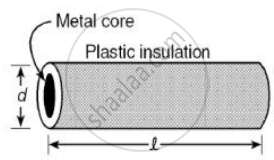Advertisements
Advertisements
Question
How does the resistance of a wire change when:
its material is changed to one whose resistivity is three times?
Solution
Resistance,
`R=l/A`
where l = length of wire
A= area of cross-section of the wire
When the material is changed to one whose resistivity is three times:
`R=(3rho)/A=3R`
APPEARS IN
RELATED QUESTIONS
What is meant by conductors and insulators? Give two examples of conductors and two of insulators.
What is the general name of the substances having infinitely high electrical resistance?
Classify the following into good conductors, resistors and insulators:
Rubber, Mercury, Nichrome, Polythene, Aluminium, Wood, Manganin, Bakelite, Iron, Paper, Thermocol, Metal coin
What do you understand by the "resistivity" of a substance?
What will be the resistance of a metal wire of length 2 metres and area of cross-section 1.55 × 10−6 m2 if the resistivity of the metal be 2.8 × 10−8 Ω m?
Calculate the resistance of a copper wire 1.0 km long and 0.50 mm diameter if the resistivity of copper is 1.7 × 10−8 Ω m.
How does the resistance of a conductor depend on:
area of cross-section of the conductor?
What would be the effect on the resistance of a metal wire of:
increasing its temperature?
Resistance of a metal wire of length 5 m is 100 Ω . If the area of cross - section of the wire is `3 × 10^-7 "m"^2` , Calculate the resistivity of the metal .

Plastic insulation surrounds a wire having diameter d and length l as shown above. A decrease in the resistance of the wire would be produced by an increase in the ______.
